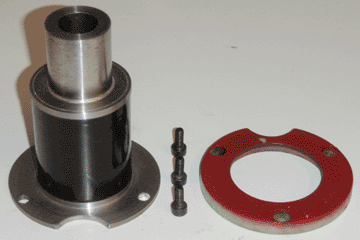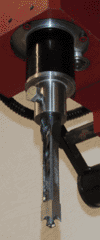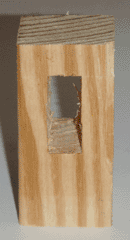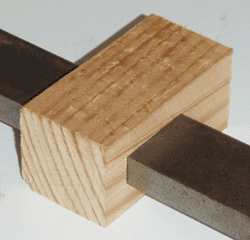




The mortise and tenon joint is one of the strongest in all of woodworking, but has unforunately been absent from my previous projects due to the difficulty of its construction. Since an upcoming project requires this type of joint, I decided to make an adapter to turn my milling machine into a hollow-chisel mortiser, since the two machines are mechanically very similar.
The adapter consists of a sleeve which surrounds the mill spindle, holding a chisel at the bottom and replacing the mill's bearing shield at the top. It is made entirely from mild steel tubing and plate, machined to size and joined together with tin-silver eutectic solder, using zinc chloride as the flux and my super torch as the heat source. It also features a decorative enamelled section, which serves to reduce the area susceptible to rust. The chisel itself is an inexpensive half-inch mortising chisel from Harbor Freight. Due to the poor quality of the supplied auger bit, I replaced it with an extra-long 3/8" twist drill; this has a better fit in my mill's 3/8" collet, and has less of a tendency to wander off course during mortising.
After some minor adjustments, the adapter performed surprisingly well in white pine, as well as in the significantly harder yellow pine, which can be seen at the top of the page. Though the initial square hole requires heavy pressure (due to the chisel cutting on all four sides), it can then be extended incrementally, requiring little more force than a typical drill. The holes formed this way are dimensionally precise, with any minor irregularities due solely to the nature of the wood. The mortise in the top right of the page was extended to exactly 1-1/4" long using the mill's handwheels, and a bar of 1/2" by 1-1/4" mild steel could just barely fit inside; it required a hammer to be driven fully though, and the resulting joint has no play whatsoever.
Overall, I am highly satisfied with the results of this project. Although it would likely struggle with larger chisels or harder types of wood, it is powerful enough for the projects I currently have in mind. In the long term I will probably transition to cutting mortises by hand, but this adapter has solved the problem in the short term, while at the same time giving me a visual reference as to what a precise mortise should look like. In the past and for other skills, I have found it beneficial to take the easy route while learning the hard one, and in the case of mortises this adapter provides that option.